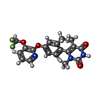登録情報 データベース : EMDB / ID : EMD-30394タイトル Cryo-EM structure of PW0464 bound dopamine receptor DRD1-Gs signaling complex 複合体 : Complex structure-3複合体 : Guanine nucleotide-binding protein G(s) subunit alpha, beta, gammaタンパク質・ペプチド : Guanine nucleotide-binding protein G(s) subunit alpha isoforms shortタンパク質・ペプチド : Guanine nucleotide-binding protein G(I)/G(S)/G(T) subunit beta-1タンパク質・ペプチド : Guanine nucleotide-binding protein G(I)/G(S)/G(O) subunit gamma-2複合体 : Nanobody 35複合体 : D(1A) dopamine receptorタンパク質・ペプチド : D(1A) dopamine receptorリガンド : CHOLESTEROLリガンド : 6-[4-[3-[bis(fluoranyl)methoxy]pyridin-2-yl]oxy-2-methyl-phenyl]-1,5-dimethyl-pyrimidine-2,4-dione / 機能・相同性 分子機能 ドメイン・相同性 構成要素
/ / / / / / / / / / / / / / / / / / / / / / / / / / / / / / / / / / / / / / / / / / / / / / / / / / / / / / / / / / / / / / / / / / / / / / / / / / / / / / / / / / / / / / / / / / / / / / / / / / / / / / / / / / / / / / / / / / / / / / / / / / / / / / / / / / / / / / / / / / / / / / / / / / / / / / / / / 生物種 Homo sapiens (ヒト) / Lama glama (ラマ)手法 / / 解像度 : 3.2 Å Yan W / Shao Z ジャーナル : Cell / 年 : 2021タイトル : Ligand recognition and allosteric regulation of DRD1-Gs signaling complexes.著者: Peng Xiao / Wei Yan / Lu Gou / Ya-Ni Zhong / Liangliang Kong / Chao Wu / Xin Wen / Yuan Yuan / Sheng Cao / Changxiu Qu / Xin Yang / Chuan-Cheng Yang / Anjie Xia / Zhenquan Hu / Qianqian Zhang ... 著者 : Peng Xiao / Wei Yan / Lu Gou / Ya-Ni Zhong / Liangliang Kong / Chao Wu / Xin Wen / Yuan Yuan / Sheng Cao / Changxiu Qu / Xin Yang / Chuan-Cheng Yang / Anjie Xia / Zhenquan Hu / Qianqian Zhang / Yong-Hao He / Dao-Lai Zhang / Chao Zhang / Gui-Hua Hou / Huanxiang Liu / Lizhe Zhu / Ping Fu / Shengyong Yang / Daniel M Rosenbaum / Jin-Peng Sun / Yang Du / Lei Zhang / Xiao Yu / Zhenhua Shao / 要旨 : Dopamine receptors, including D1- and D2-like receptors, are important therapeutic targets in a variety of neurological syndromes, as well as cardiovascular and kidney diseases. Here, we present five ... Dopamine receptors, including D1- and D2-like receptors, are important therapeutic targets in a variety of neurological syndromes, as well as cardiovascular and kidney diseases. Here, we present five cryoelectron microscopy (cryo-EM) structures of the dopamine D1 receptor (DRD1) coupled to Gs heterotrimer in complex with three catechol-based agonists, a non-catechol agonist, and a positive allosteric modulator for endogenous dopamine. These structures revealed that a polar interaction network is essential for catecholamine-like agonist recognition, whereas specific motifs in the extended binding pocket were responsible for discriminating D1- from D2-like receptors. Moreover, allosteric binding at a distinct inner surface pocket improved the activity of DRD1 by stabilizing endogenous dopamine interaction at the orthosteric site. DRD1-Gs interface revealed key features that serve as determinants for G protein coupling. Together, our study provides a structural understanding of the ligand recognition, allosteric regulation, and G protein coupling mechanisms of DRD1. 履歴 登録 2020年7月20日 - ヘッダ(付随情報) 公開 2021年3月3日 - マップ公開 2021年3月3日 - 更新 2025年7月2日 - 現状 2025年7月2日 処理サイト : PDBj / 状態 : 公開
すべて表示 表示を減らす
 データを開く
データを開く 基本情報
基本情報 マップデータ
マップデータ 試料
試料 キーワード
キーワード 機能・相同性情報
機能・相同性情報 Homo sapiens (ヒト) /
Homo sapiens (ヒト) / 
 データ登録者
データ登録者 引用
引用 ジャーナル: Cell / 年: 2021
ジャーナル: Cell / 年: 2021

 構造の表示
構造の表示 ムービービューア
ムービービューア SurfView
SurfView Molmil
Molmil Jmol/JSmol
Jmol/JSmol ダウンロードとリンク
ダウンロードとリンク emd_30394.map.gz
emd_30394.map.gz EMDBマップデータ形式
EMDBマップデータ形式 emd-30394-v30.xml
emd-30394-v30.xml emd-30394.xml
emd-30394.xml EMDBヘッダ
EMDBヘッダ emd_30394.png
emd_30394.png emd-30394.cif.gz
emd-30394.cif.gz http://ftp.pdbj.org/pub/emdb/structures/EMD-30394
http://ftp.pdbj.org/pub/emdb/structures/EMD-30394 ftp://ftp.pdbj.org/pub/emdb/structures/EMD-30394
ftp://ftp.pdbj.org/pub/emdb/structures/EMD-30394 emd_30394_validation.pdf.gz
emd_30394_validation.pdf.gz EMDB検証レポート
EMDB検証レポート emd_30394_full_validation.pdf.gz
emd_30394_full_validation.pdf.gz emd_30394_validation.xml.gz
emd_30394_validation.xml.gz emd_30394_validation.cif.gz
emd_30394_validation.cif.gz https://ftp.pdbj.org/pub/emdb/validation_reports/EMD-30394
https://ftp.pdbj.org/pub/emdb/validation_reports/EMD-30394 ftp://ftp.pdbj.org/pub/emdb/validation_reports/EMD-30394
ftp://ftp.pdbj.org/pub/emdb/validation_reports/EMD-30394 リンク
リンク EMDB (EBI/PDBe) /
EMDB (EBI/PDBe) /  EMDataResource
EMDataResource マップ
マップ ダウンロード / ファイル: emd_30394.map.gz / 形式: CCP4 / 大きさ: 38.4 MB / タイプ: IMAGE STORED AS FLOATING POINT NUMBER (4 BYTES)
ダウンロード / ファイル: emd_30394.map.gz / 形式: CCP4 / 大きさ: 38.4 MB / タイプ: IMAGE STORED AS FLOATING POINT NUMBER (4 BYTES) 試料の構成要素
試料の構成要素 解析
解析 試料調製
試料調製 電子顕微鏡法
電子顕微鏡法 FIELD EMISSION GUN
FIELD EMISSION GUN
 ムービー
ムービー コントローラー
コントローラー



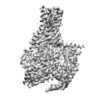









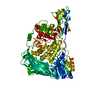


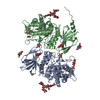
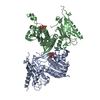
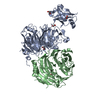
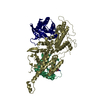
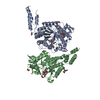
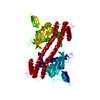






















 Z (Sec.)
Z (Sec.) Y (Row.)
Y (Row.) X (Col.)
X (Col.)
























